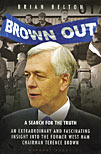 A Search for the Truth
A Search for the Truth
by Brian Belton
Pennant Books, £16.99
Reviewed by Darron Kirkby
From WSC 254 April 2008
In Len Shackleton’s autobiography, a chapter entitled “What the average director knows about football” famously comprised a blank page. Brian Belton, on the other hand, manages to eke more than 270 pages out of Terence Brown’s 15-year tenure as chairman of West Ham United.
The main problem with Brown Out is quickly apparent – that it falls between two stools. The period in question (from 1992 to 2006) may have been the most tumultuous in the club’s history, and the book may be subtitled “an extraordinary and fascinating insight into former West Ham chairman Terence Brown”, but, other than Ken Bates, the lives of few chairmen merit this many pages. Consequently, the book is more of an off-the-pitch history of West Ham in these years.
On that level, Belton covers some incidents well, such as the conflict with the fans’ group WHISTLE, which was seeking Brown’s resignation following the fire-sale of the club’s “crown jewels” (Joe Cole, Glen Johnson, Jermain Defoe, Michael Carrick, David James, Trevor Sinclair, Fredi Kanouté and Paolo Di Canio), plus the Icelandic takeover and the Carlos Tevez rumpus.
But Belton clearly has a personal agenda; while Harry Redknapp and Alan Pardew come in for some vehement criticism, little is said about Glenn Roeder, whose appointment and tenure over the best side ever to be relegated from the top flight most fans would argue was Brown’s biggest mistake (rather than losing Billy Bonds as manager, as Belton asserts). The issue of a fully fit Di Canio sitting at home during the run-in to relegation in 2001-02 is not even mentioned.
Although Belton attempts to assess Brown’s perceived failings, he always comes out in support of the ex-chairman. He calls him a “genius”, claims his legacy includes the higher attendances when he left the club and says Brown’s detractors “might be hard pressed to name a West Ham chairman who bettered his performance”. One passage particularly grates: “Few fans will forgive Brown for the loss of so many world-class players. However, the club is a Premiership outfit and Upton Park [sic] is a ground fit for that status.” But smaller clubs have achieved this without selling £60m-plus of talent, including almost half the current England team.
Belton is the most prolific writer in the history of the club. This is his 14th book in the past 11 years and at times the book feels as if he is just trying to fulfil his contractual obligations. His prodigious output is probably to blame for several errors. A continuity mistake in an unnecessary page on Kia Joorabchian’s life-story should have been picked up by a proof-reader, but getting the dates of big games wrong and even the name of the company that sponsored the club for five years is a sign of overwork.
The prose is at times self-indulgent, with Belton all too keen to assert himself on the narrative via irrelevant asides. There are also several tortured analogies; rehashing Monte Python’s Dead Parrot sketch with a Hammers Bond as the subject is cringeworthy. In conclusion, the book goes on too long – much like Brown’s tenure at the Boleyn Ground.